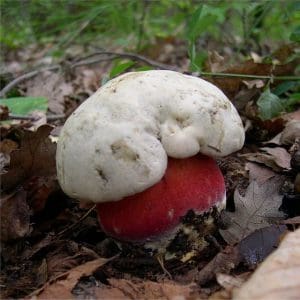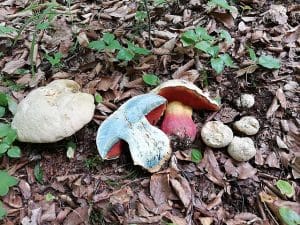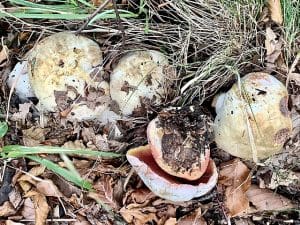Devil’s Bolete / Summer / Autumn / Toxic
The Devil’s Bolete (Rubroboletus satanas) is a striking and rare species of mushroom found in woodlands across parts of UK and Europe.
Known for its vibrant colours and imposing appearance, it is one of nature’s most deceptive fungi.
While its vivid red stem and yellowish cap may draw curious foragers, the Devil’s Bolete hides a dangerous secret: it is highly toxic.
Consuming this mushroom can result in severe gastrointestinal distress, making proper identification crucial.
This article will guide you through the key features of the Devil’s Bolete and explain the risks associated with its toxicity, ensuring that you stay safe when foraging in the wild.
Firstly this bolete fits to our general bolete rule found in our Mushroom Foraging Guide – Red or Blue may make you spew
Scientific Name
Boletus / Rubroboletus satanas
Common Names for the Devil’s Bolete
Devil’s Bolete, Satan’s bolete
Family
Boletaceae
Habitat
They are mycorrhizal with Oak and Beech and are mainly restricted to chalky parts of southern England.
Description
A toxic member of the Bolete family, however they are quite rare and there are no recorded fatalities in the UK.
Identifying Features of the Devil’s Bolete:
Cap:
It is one of the largest boletes found in the UK and caps can sometimes measure an impressive 50 cm in diameter.
When young the cap is hemispherical with an inrolled margin, but becomes convex with age.
When young, the upper surface is grayish white or buff, but older specimens tend to develop olivaceous, or brownish tinges. The surface of the cap is greasy when young becoming smooth and suede like with age.
The flesh will slowly turn blue when handled going back to the original yellow colour after a few minutes.
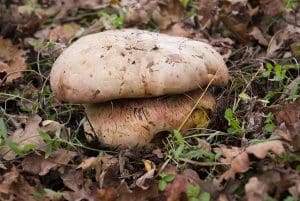
Stem:
The stems are generally 5–15 cm long, tapering towards the base. The upper stem is yellow to orange becoming redder towards the base. Usually covered in a fine red reticulation or mesh.
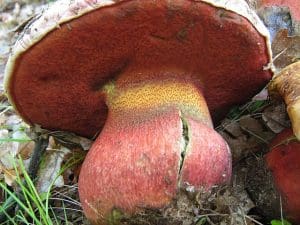
Pores:
When young the pores are yellowish but soon turn orange and then red as the spores mature. Pores near the margin are paler than those nearer to the stem.
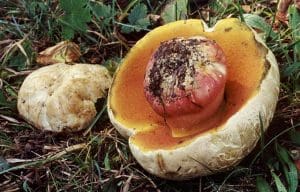
Smell:
No distinctive smell when they are young but putrid smelling with age.
Spores:
Olive green to brown.
Known hazards
The Devil’s Bolete (Rubroboletus satanas) contains a variety of toxic compounds that pose significant risks to human health if ingested. The primary toxins responsible for its harmful effects are gastrointestinal irritants, including muscarine and bolesatine. These substances attack the digestive system, causing a range of unpleasant and sometimes dangerous symptoms.
Muscarine is a well-known toxin found in several species of poisonous mushrooms. It acts on the parasympathetic nervous system, leading to symptoms such as excessive salivation, sweating, and gastrointestinal upset. Severe poisoning can result in respiratory issues and, in extreme cases, death. More information about muscarine and its effects can be found on the National Poisons Information Service (NPIS).
Bolesatine is a lesser-known toxin found in certain boletes, including the Devil’s Bolete. This protein-based toxin can cause gastrointestinal distress and may also have cytotoxic effects, damaging cells in the body. For more information on bolesatine and its effects, resources such as the UK Fungal Biodiversity Centre can be consulted.
Symptoms of poisoning by these toxins usually manifest within 30 minutes to three hours of ingestion and can include severe nausea, vomiting, abdominal pain, and diarrhoea. If the mushroom is consumed in larger quantities, dehydration and electrolyte imbalances can occur due to prolonged symptoms, potentially leading to more serious complications.
Although fatalities from Devil’s Bolete poisoning are rare, the toxins can cause considerable distress and discomfort. Since there is no specific antidote, treatment typically focuses on symptom management, including rehydration and supportive care in a medical setting. For further information on mushroom poisoning, you can visit the UK National Health Service (NHS) website.
Potential lookalikes for the Devil’s Bolete
They are quite distinctive but could possibly be confused with the Lurid Bolete (Suillellus luridus) but this has a darker cap and it blues instantly when cut.
The Scarletina Bolete (Neoboletus luridiformis) also looks similar but again it has a darker cap.
From a safety point of view it’s probably best to avoid any red pored boletes.
Extra Notes
There are references to it being eaten in some parts of Europe after thorough boiling which apparently neutralizes the toxins but there is no scientific evidence that this works.
References:



